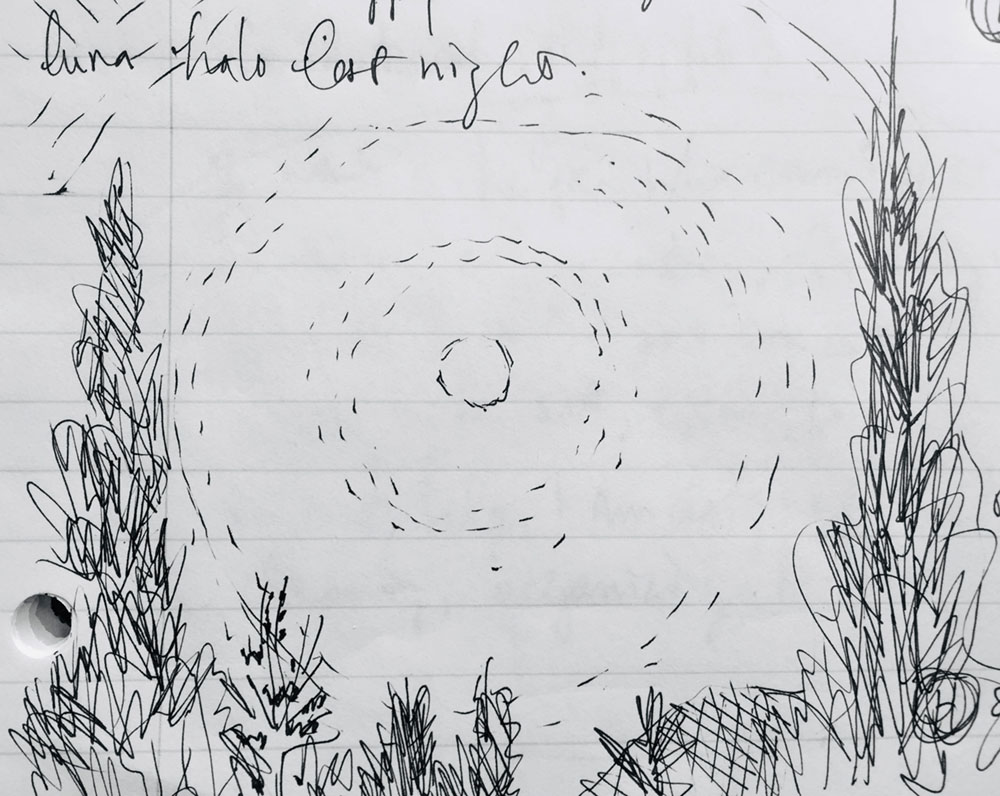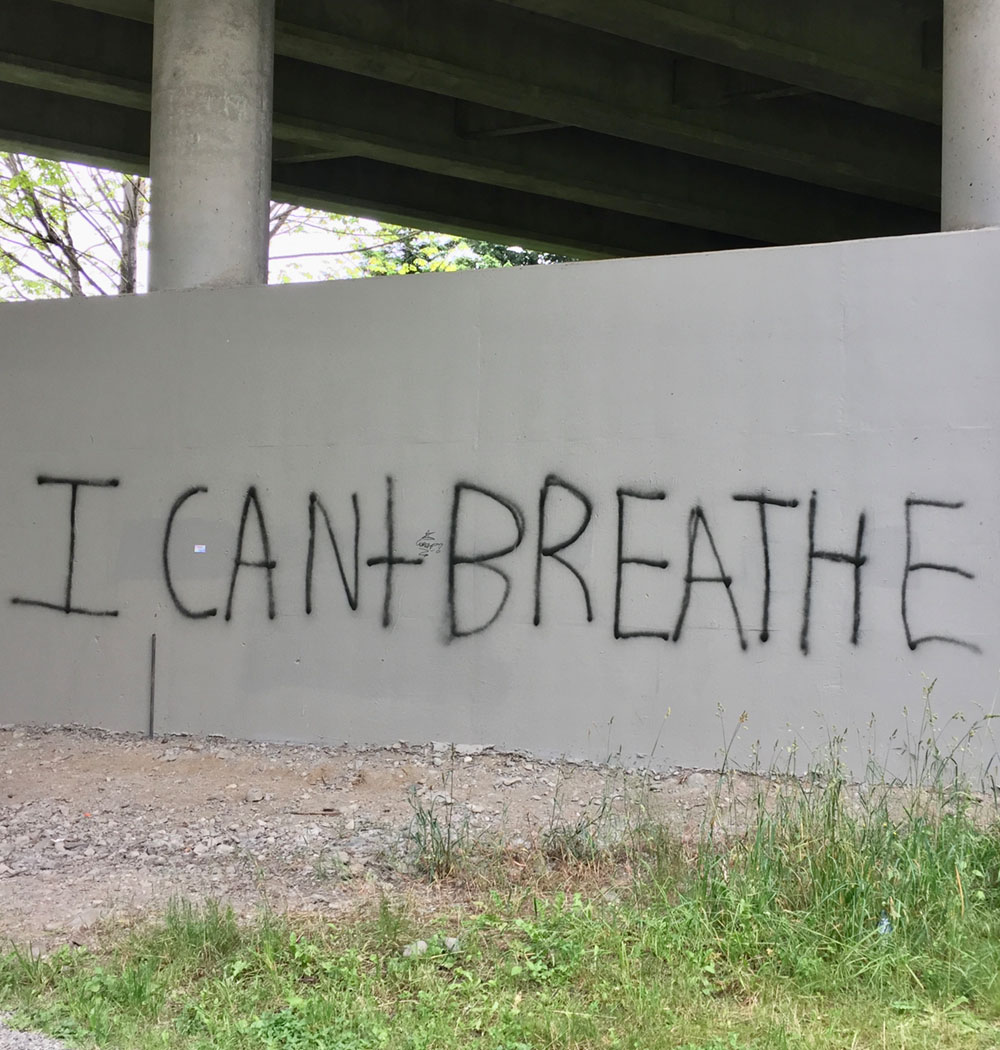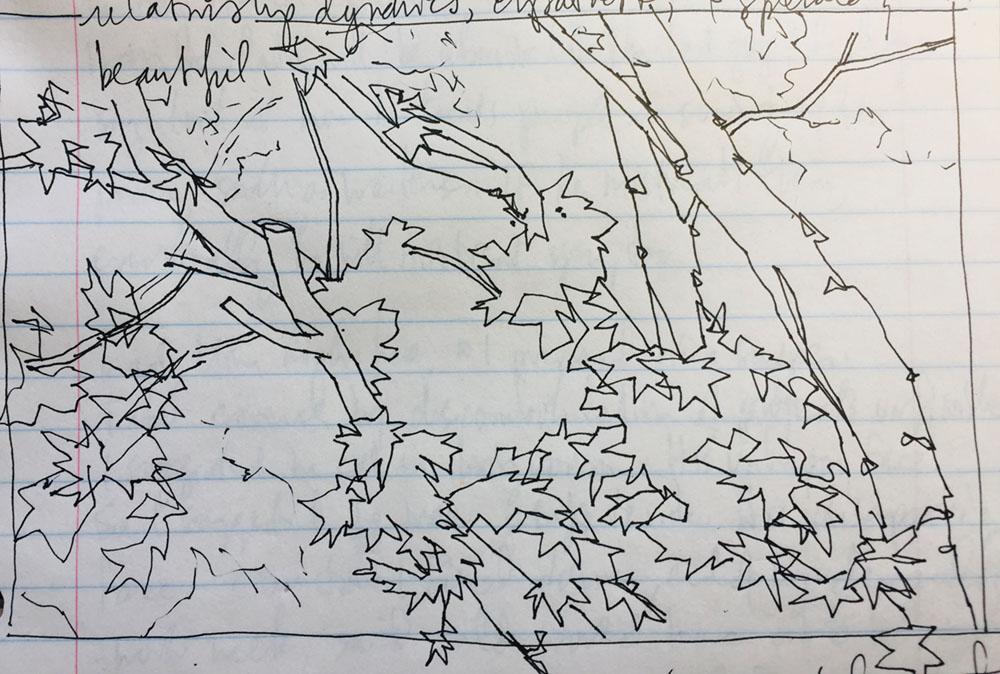
Abstract
From the perspective of a white mental health counselor, artist, and mother, Denita Benyshek offers a personal narrative that weaves together the experiences of individuals, families, and society during the initial wave of the COVID-19 pandemic, growing awareness of systemic racism and police brutality, and the upsurge of Black Lives Matter protests. Multiple data sources are integrated, including online news, research websites, social media posts, clinical research, drawings, graffiti, photographs by community members, and observations by psychotherapy clients.
Social stressors and symptoms of stress, loss, grief, and post-traumatic stress disorder are considered, while adaptations of individuals, couples, families, and communities demonstrated everyday creativity that resulted in personal growth, strengthened relationships, heightened resilience, and contributed to needed social change.
The author provides an insider view of events from March through June, 2020, using creative nonfiction and arts-based inquiry, towards illuminating the experience of this time to offer validation, meaning, inspiration, hope, and connection to contemporary readers as well as information for future researchers in the social sciences.
Keywords: coronavirus, COVID-19, pandemic, Seattle, King County, police brutality, George Floyd, Black Lives Matter, BLM, post-traumatic stress disorder, trauma, PTSD, grief, protest art, dance, hedonometer, journaling, everyday creativity, resilience, social justice, change, creative nonfiction, arts-based inquiry
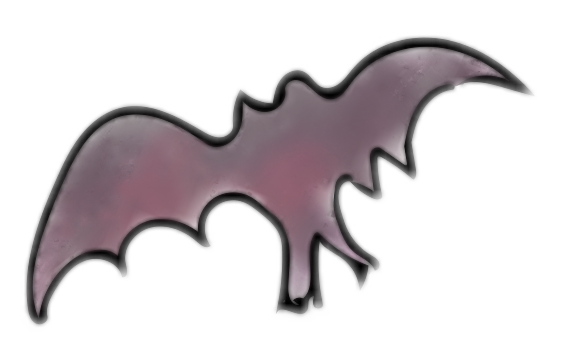
I live in King County, Washington, where the initial outbreak of COVID-19 exploded in the USA. Suddenly, leaving home felt dangerous. Shopping felt dangerous. Going to work felt dangerous.
I provide mental health counseling, specializing in treatment of post-traumatic stress disorder (PTSD), serving gifted and talented adults and teens, as well as folks with chronic illness. In March, my office lease was due for renewal. Tired of the sixty-minute commute, dense traffic, and driving home in the winter dark through pounding rain, I was already considering moving my practice closer to home. As the number of infections and deaths rose, the dominoes of society fell rapidly: airline flights and film festivals and elective surgeries and music performances cancelled, farmers markets and schools and restaurants closed, grocery store shelves emptied. In Washington, a stay-home order seemed ever more likely.
March 10th, I decided to not renew my lease. On March 12th, the hedonometer measured the deepest trough of sadness and distress on Twitter in more than a decade (Vermont Complex Systems Center – Computational Story Lab, 2020; Viglione, 2020).
March 23rd, our governor issued the stay-home. By this date, the stock market had crashed, with the Dow Jones falling 37% (Team, 2020). With the help of my boyfriend and my son, I moved out of my office of ten years and gave away my beloved antique furniture, donating sand tray toys and books in my professional library. I informed my clients that future sessions would be via telehealth.
Preferring in-person counseling, or overwhelmed by overtime as frontline medical workers, or suddenly unemployed, weeping clients cancelled sessions. A single parent, I experienced a sudden drop in income. Most of my colleagues lost 30% of their clients.
Life-as-we-knew-it crashed to a halt. Our communities, our families, and our individual selves experienced rapid waves of disruption, loss, and grief. Families were thrown together without childcare, without breaks, while homeschooling children and working from home, or suffering the financial stress of unemployment and worrying how to pay bills and buy groceries, or single, childless, not even a cat or goldfish, suffering the loneliness of solitary confinement, or declared an essential worker required to work even though childcare was almost nonexistent and some work places were rapidly becoming hotbeds of infection.
Everything was magnified. If a marriage was already rocky, it was now boulder-strewn. Troubled couples cancelled exotic vacations where they imagined reconnecting with joy. Teens were isolated from friends, their trusted bulwark against cutting and suicide. My son decided to not enroll in college to protect my health, and I didn’t want him to enroll to protect his health – both of us in the vulnerable group. He considered virtual learning, but knows he needs live human contact and community to learn. Every day brought a deluge of emails with data, research, guidance, and ever-changing orders regarding the pandemic, from psychiatric list servs, professional associations, liability insurance, King county, and the state’s Department of Health.
As life became more unpredictable, social and economic inequities loomed larger (Aschoff, 2020). Some folks could work from home and sustain their income. Other folks, often underpaid, risked their lives to feed their families, as meat packing plant employees (Molteni, 2020) or as emergency medical technicians trying to revive people dying from COVID-19 (Saslow, 2020). Poor children and rural children could not easily access reduced-cost meals at schools (Abad-Santos, 2020) or the internet for online lessons (Mansfield & Conlon, 2020), while food lines stretched longer and longer (Amaria & Zhou, 2020). Almost 46 million Americans filed for unemployment (Schneider, 2020), domestic violence increased (The Economist, 2020), sales of alcohol climbed (Chiwaya, 2020), and the rate of depression and anxiety soared to 34% (Fowers & Wan, 2020).
Holding life together became much harder. I heard many metaphors. “It’s like Little House on the Prairie where we can only rely on immediate family for all our needs.” “It’s like we’re civilians during wartime” when life is uncertain, with shortages and a daily sense of threat. “It’s like a train wreck that never ends.” The rapid rate of change required ongoing adaptation.
Many sources of entertainment and favorite activities were no longer available. Without frenetic busyness, some folks became more mindful of dysfunctional patterns, avoidance, and other negative ways of coping, leading to recognition of problems, action plans, and change. Within their own souls and with their loved ones, people created new ways to meaningfully connect. Career-obsessed parents re-engaged with their children and spouses. Couples began playing duets. Parents and children made art and tended gardens and baked together. Formerly scattered families gathered each evening to watch, and discuss, episodes of a favorite series.
Indicative of personal change, clogged closets and stuffed kitchen cabinets and overflowing personal libraries were sorted and purged. Some folks became more mindful of addictions and reduced their dependence, improved nutrition, and moved into healthier lifestyle patterns. Troubled couples engaged in necessary conversations, unable to bear the stress of remaining silent, moving forward in the midst of so many unknowns. In these many changes, I witnessed the processes of everyday creativity described by Richards (1999) as a “survival capability – representing the ‘phenotypic plasticity’ that allows humans to adapt to changing environments – and a humanistic force in ongoing growth, personal development, and even transcendence” (p. 684).
Without the time sinkhole of commuting, I began morning journal writing for the purpose of listening to my own soul and sorting through my thoughts. On sunny days, I’d write while rocking in a swing, beside the pond and waterfall. If cool or raining, I’d write facing windows that frame the mountains. I’d look up from my notebook and draw, enjoying a moment of restorative contemplation and peace.
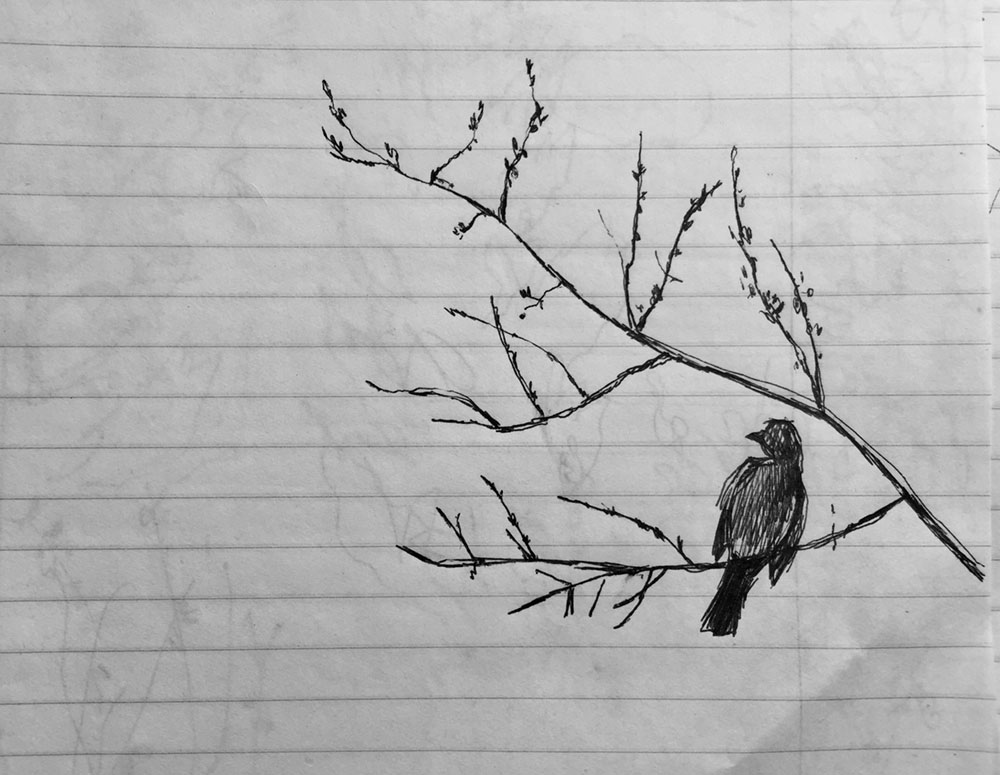
Benyshek, Denita (2020). Robin in a Wild Cherry Tree, artist’s collection. Pen and ink on notebook paper.
I re-entered the creative life, learning to speak again after my voice was stolen by trauma. After that, I could not easily enter my art studio and stopped exhibiting. Thanks to the slower pace of pandemic life, I started writing and drawing again, with visions of paintings and gallery exhibits that would lighten and heal the souls of my audience.
By March 29th, I was sick, with a night of crushed-in-a-vice body pain, and unending, bone-freezing, chill. I suffered weeks of sore throat, earache, disabling fatigue, endless headache, and cognitive problems with weak memory and slower word retrieval. My eyes turned red.
On April 6th, another wave of stress hit when the governor announced schools would remain closed the rest of the school year and distance learning was required. Some students found they preferred this method, away from bullies, cliques, gossip, crowds, able to move at their own pace, no longer bored. Other students found distant learning too abstract. Floundering, they were unable to concentrate or be productive, needing the presence of a teacher and classmates to help regulate emotion and behavior. Meanwhile, rates of pandemic infections and deaths mounted ever higher, while silent, masked shoppers fearfully recoiled from each other.
April 7th was a full moon.
The following week, several past clients contacted me, desperately needing to return to therapy to address problems they could previously ignore, make changes previously avoided, treat traumas previously suppressed. Despite being sick, I kept working, wrapped in sweaters, gazing at small, sometimes pixelated, telehealth images of clients who depend on me to help them heal, earning income to support myself and my son. Then, a wave of new clients reached out for treatment of past childhood abuse and domestic violence. My client load is more than full. Between sessions, to give myself a break and a moment of peace, I’d walk outside, gazing at the trees and ever-changing clouds, taking deep breaths of mountain air.
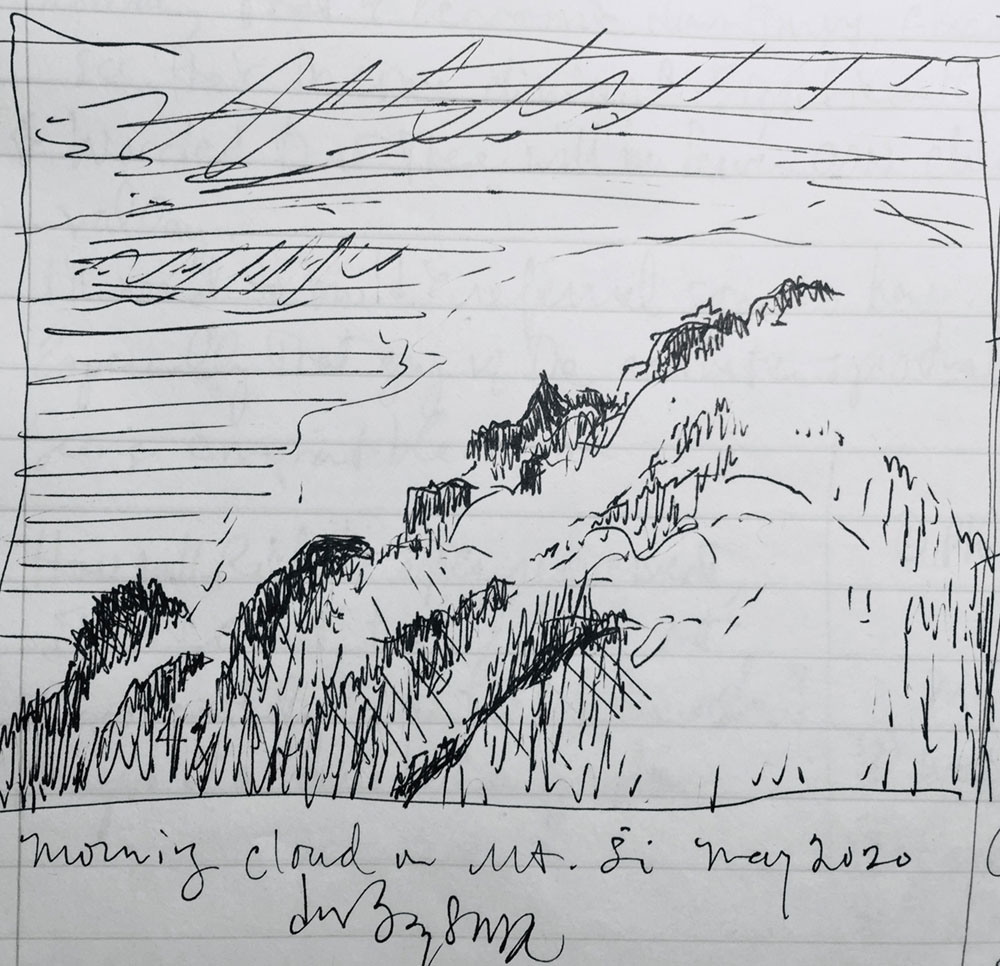
Denita Benyshek (2020). Morning Cloud on Mt. Si, artist’s collection. Pen and ink on notebook paper.
Still sick, a 30-minute drive to a coronavirus test site felt like too great an effort and, at that time, the tests were only available to a small population that met narrow criteria. I decided against getting the coronavirus test. My oxygen saturation level was fine. I could breathe.
On May 25th, the murder of George Floyd was video-recorded by a brave girl with a smartphone, and our nation heard Mr. Floyd say, “I can’t breathe” (McLaughlin, 2020). His neck under the knee of a white police officer, Mr. Floyd called for his mother and we mothers heard his plea. I saw the officer’s expression, eyes on fire with excitement, appearing to relish the experience. Days passed, the police officer was not charged with murder.
For generations, my black brothers and sisters suffered from personal and systemic racism, which created chronic stress with ongoing negative effects on mental and physical health (American Psychological Association, 2013). Black Americans already knew about the prevalence of police brutality (Oppel & Gamio, 2020) and the dangers of falling asleep in one’s own car (Carissimo, 2020) or sleeping in one’s own bed (Michaels, 2020) or going out jogging (McLaughlin, 2020) or playing video games with one’s nephew (BBC, 2019). Even watching birds in a park is suspicious (Bittel, 2020; Hannon, 2020). Thanks to smartphone videos, police brutality against black citizens became more widely known, which sadly caused vicarious trauma and African American children experienced even higher levels of stress and worsening signs of trauma (Jackson, 2020).
May 31st, the hedonometer plunged to an even deeper level of sadness and angst – as society exploded into Black Lives Matter (BLM) protests across the USA (Viglione, 2020). Was this an unexpected gift of the coronavirus pandemic? People already on edge. So many unemployed or working from home or not attending classes and other activities, available to march day after day? Previously silent, eerily empty streets and bridges and freeways filled with mostly peaceful protestors. Hundreds of videos of police brutality against protestors and journalists were recorded and posted on Twitter (Doucette, 2020; Way, 2020). The need for the revolution was televised.
In my little town, high school students organized a protest attended by 500 folks on June 6th (McCall, 2020).
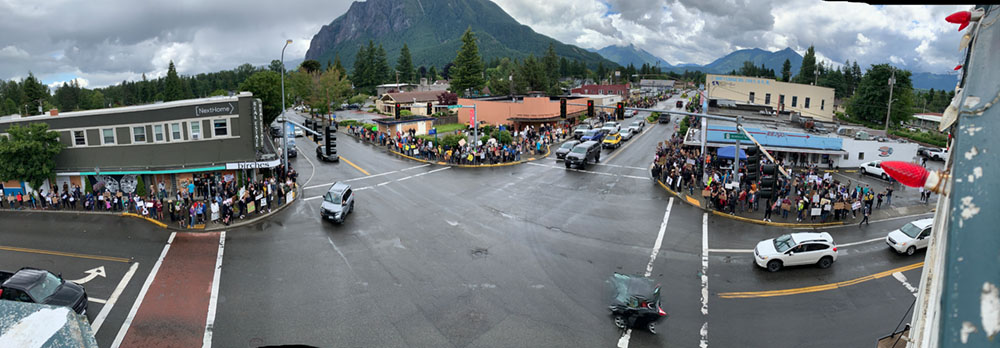
Luke Talbott (June 6, 2020). Black Lives Matter Protest, North Bend, WA. Photograph. Reprinted with permission.
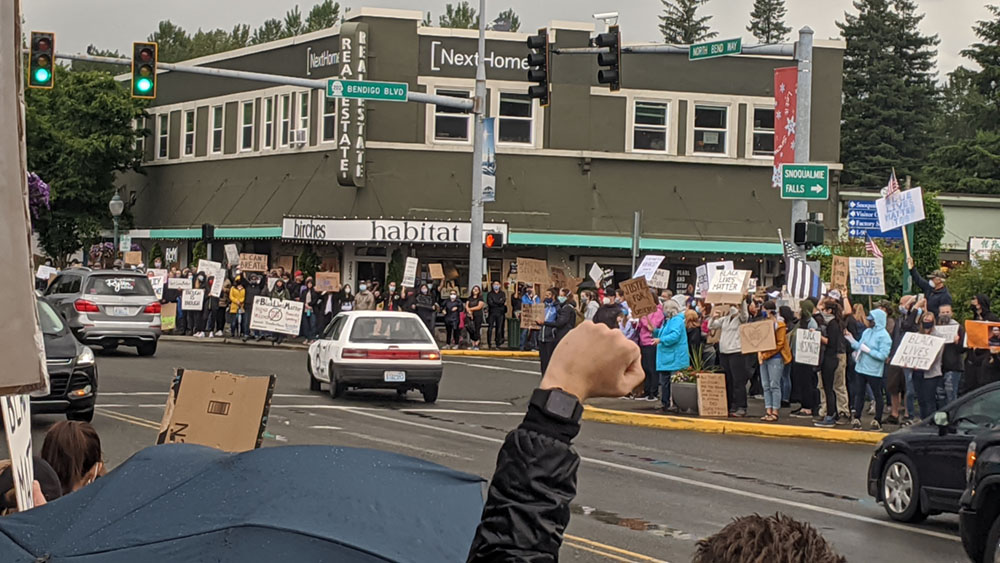
Robert Newcomer-Dyer (June 6, 2020). Man Raising Fist at Stand in Solidarity Protest, North Bend, WA, Photograph. Reprinted with permission.
The law-abiding protestors were flanked by men with firearms, including assault rifles. Alarmed by online conspiracy theories and news reports of looting and burning, the armed men were intent on protecting businesses and people against the antifa. However, the guns made the peaceful protestors feel unsafe. Some adults, recognizing potential danger, left early with their children, while other folks chose to not attend. Afterwards, on the social media website NextDoor, my neighbors of color described not being served in local restaurants.
Everyone I encountered was disturbed and distressed. Almost every client talked about the heartrending trauma of experiencing and witnessing racism. There was another wave of folks requesting counseling, but my practice was more than full, I was still suffering post-viral symptoms, already gave unemployed clients fee discounts, and could not push myself to work more hours.
I look up from writing. I see an elegant maple tree and I draw lines that are sharp and jagged.
Everywhere I look, I see symptoms indicating post-traumatic stress syndrome (PTSD). According to the American Psychiatric Association (2017), a trauma-triggering event can be exposure to death, threatened death, actual or threatened injury. The exposure can be direct, as the recipient, or indirect, as a witness or hearing that a family member or friend was traumatized. Indirect exposure to “aversive details” of trauma, seeing videos or reading newspapers, can also cause PTSD. Thus, watching the video of George Floyd’s murder is traumatizing. Watching journalists attacked by police is traumatizing. Watching police shove, beat, throw, and injure peaceful demonstrators is traumatizing. Reading reports of protestors blinded by rubber bullets is traumatizing. Seeing police officers assaulted is traumatizing, too.
Many clients, session after session, described intrusion symptoms indicative of PTSD: unwanted and upsetting memories, nightmares, flashbacks, emotional distress, or physical reactivity. No-one was sleeping peacefully. People struggling with chronic illness suffered worsening symptoms, everything flaring, as cars and police stations burned.
June 8th, a New Jersey Department of Corrections officer was recorded reenacting the death of George Floyd, yelling and kneeling on the neck of a dummy, while protestors walk by (del Valle, 2020). June 25th, three police officers were fired after a video reveals an intent to purchase an assault rifle to kill black Americans, and a rant of vile insults (Elfrink, 2020). June 26th, Newsweek reports that former police officers were openly planning, on Facebook, to murder a BLM activist (Kim, 2020). June 28th, the president retweets a video where a supporter shouts “White power!” (Mansoor, 2020). These insane acts of hate were only a few, of many, examples revealed daily, and my intuition is that the hatred and violence will continue, even worsen, through the rest of this year. My clients of color and my Jewish clients consider fleeing the nation that is their home. They do not feel safe here.
As victims and witnesses of racial trauma share their stories in the media and online (Adams, 2020), more of my white brothers and sisters realize that silence enables abuse (Clarke, 2020), undertaking the process of further educating themselves about systemic racism. My clients also share their stories of racist attacks endured by them or their loved ones, what they are doing to support social justice, moving from a place of helplessness into action, finding their voices and taking action within their spheres of influence. I keep writing, sculpting emotion into these sentences and paragraphs.
Research on trauma treatment found that communal events where people are moving together as a group, such as singing in a choir or doing meditative yoga (van der Kolk, 2006, van der Kolk et al., 2014), helps heal trauma. I saw thousands of protestors marching, chanting in unison. Two blocks from the White House, protestors sang together, twinkling lights of phones held high (Gostanian, 2020). Protestors danced, solo and in unison, performing traditional African dances, the Maori haka, hip hop, and expressive modernism (Burdon-Manley, 2020). Fourteen-year-old ballet dancers, in black net tutus, performed on a graffiti-defaced statue of Robert E. Lee (Curran, 2020). Tens of thousands of BLM protestors, around the world, danced the electric slide in unison. Roy (2020) commented:
Euphoria is one reason why dancing goes with uprising, but it is not the only one. Look at the clips and you’ll notice that nearly every dance is collective. They bring different people – black and white, protesters and bystanders, sometimes the police – into alignment. Everyone moves in sequence, with space in between. These dances are unifying actions, collective actions – not working towards a goal, but rather bringing people together in a wordless way.
Whatever else it may be, dancing is not fighting. It is ordered without being forced; it is peaceful but not passive protest. And finally, these dances – unlike staged flash mobs or art-activist events – are unauthorized. They belong to whoever is doing them. They are, very literally, movements of the people.
I watch the videos of singing and dancing, tears in my eyes. Instead of isolation, silence, and victimhood, I see people chanting with one voice, determined, communal, seen and heard, healing trauma. I see collaboratively created, multi-media memorials that provide a place for communal grieving.
In bold letters, BLACK LIVES MATTER is painted on the street of Washington, D.C., where peaceful protestors were aggressively pushed back with tear gas and flash bang grenades to make way for a presidential campaign ad shoot (Oprysko, 2020), then painted in many cities across the USA (Dafoe, 2020). In Seattle, each colorful letter is designed by a different artist, with children joining in the painting.
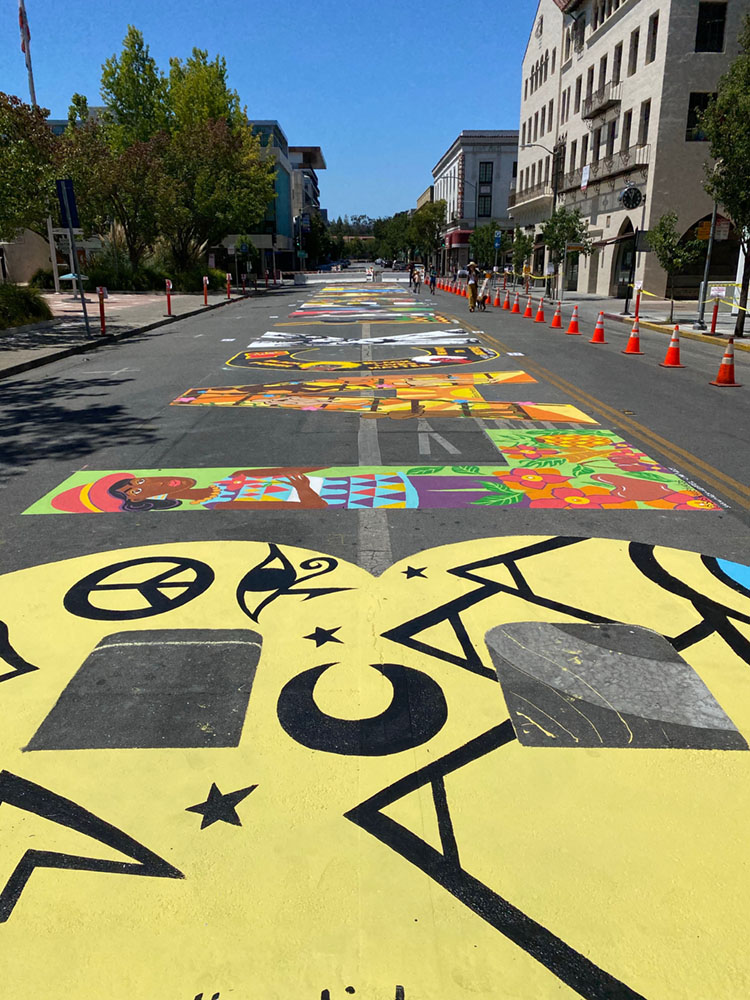
Anna Eshoo (2020, July 2). Black Lives Matter street mural, Palo Alto, California, Digital Image. United States Congress.
In these actions, I see people healing their trauma, collectively. Recognizing history in the making, curators (from the National Museum of African American History and Culture, the Smithsonian’s National Museum of American History, the Anacostia Community Museum, and the Washington, D.C. archives) conversed with volunteers carefully removing protest posters from the security fence surrounding the White House (Kahlil & Ellgren, 2020), interested in obtaining objects for their collections.
In our time of coronavirus and Black Lives Matter, we can choose actions that promote individual and societal resilience, “the process of adapting well in the face of adversity, trauma, tragedy, threats, or significant sources of stress,” knowing that resilience offers many opportunities for “profound personal growth” (Palmer et al., 2012). To strengthen resilience, the American Psychological Association recommends:
- prioritizing meaningful personal relationships,
- joining groups that provide social support and foster hope,
- caring for physical health through good nutrition, adequate sleep, and exercise,
- developing mindfulness,
- finding purpose by helping others,
- solving problems proactively,
- moving towards realistic goals,
- finding opportunities for self-discovery, and
- seeking help when you need support (Palmer et al., 2012).
We can each affect change and when we are united in action, our sphere of influence is greater than a single individual. As of June 22, 2020, almost 4,000 cities and towns, across our planet, held BLM protests (CreosoteMaps, 2020).
Now, our governor pledges state review of another death at the hands of police. Now, a few Confederate statues are toppled or removed (Philimon, Hughes, & della Cava, 2020) and the government of Mississippi begins taking action to remove the image of the Confederate flag from the state’s flag (Pender & Skinner, 2020). Now, politicians consider prohibiting the use of neck restraints and chokeholds by police (Kaur & Mack, 2020). Now, the National Football League Commissioner states publicly that it was wrong to be against peaceful protests by football players (Maske, 2020). In response to the #StopHateforProfit campaign (Guynn, 2020), over 100 companies joined the boycott against Facebook and pledged to halt advertising (Tyko, 2020) until Facebook takes concrete steps against racism on its platform. These changes would not have occurred without days and days of protests.
Meanwhile, new cases of coronavirus in the USA reached the highest single-day rate of confirmed infections on June 26th and, at that time, over 100,000 were dead from COVID-19. Already inadequate, federal support for testing will soon cease in several states with rising rates of illness (Johnson, 2020). The border with Canada remains closed (Lastoe, 2020), the European Union is formalizing a ban on travelers from the USA (Slotnick, 2020), and several east coast states now require 14 days of quarantine by folks travelling from states with rising rates of infection (Levenson, 2020). The International Monetary Fund predicts widescale, devastating, global economic collapse (Rappeport, 2020) and the Dow Jones falls again. I am finding it difficult to conclude this essay with all of these ongoing stressors. The train wreck is not over.
In a parking lot, groceries are loaded into my car by a young man wearing a mask. With genuine concern in his voice and eyes, he asks, “How are you doing?” I respond and thank him for his service. He asks what I do, I tell him I work as a mental health counselor. With passion, he thanks me for my work and tells me how important it is, touching my heart.
I take my car in for service. Behind the counter, another masked young man sincerely inquires how I’m doing. We engage in heartfelt conversation. When I pick up my car, it’s freshly washed because, from my voicemail recording, he learned that I’m a doctor and he wants me to know that my work is appreciated. His words brought me to tears. At this time, everything is magnified, even appreciation. They care. I care.
I get a lab order for a coronavirus antibody test. I look up from my journal, that container where I put the pieces of the world together, gaze out the window, and draw three branches at the top of a hazelnut tree, seeing new growth.
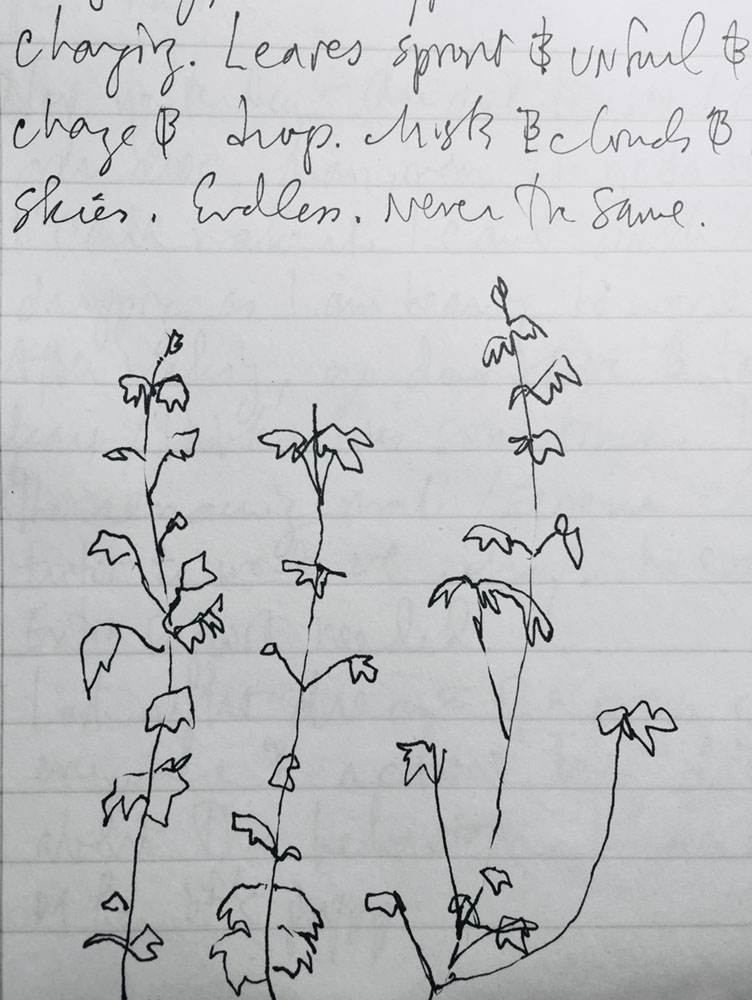
Denita Benyshek (2020). Hazelnut Tree, Changing, collection of the artist. Pen and ink on notebook paper.
References
Abad-Santos, A. (2020, March 28). How US schools are (and aren’t) providing meals to children in the Covid-19 crisis. Retrieved June 22, 2020, from https://www.vox.com/2020/3/28/21197965/coronavirus-school-shutdown-free-meals
Adams, J. (2020, June 23). White Southerners, our souls are at stake. We must speak up now. Retrieved June 23, 2020, from https://www.cnn.com/2020/06/23/opinions/white-southerners-must-speak-about-racism-adams/index.html
Amaria, K., & Zhou, L. (2020, May 09). The current hunger crisis in the US, in photos. Retrieved June 22, 2020, from https://www.vox.com/2020/5/9/21251895/food-banks-lines-pandemic
American Psychological Association. (2013). Physiological and psychological impact of racism and discrimination for African Americans. Retrieved June 15, 2020, from https://www.apa.org/pi/oema/resources/ethnicity-health/racism-stress
BBC. (2019, October 13). Woman shot dead by Texas police through bedroom window. Retrieved June 19, 2020, from https://www.bbc.com/news/world-us-canada-50032290
Benyshek, D. (2020). Hazelnut Tree, Changing [Pen and ink on notebook paper]. Artist’s Collection, North Bend, WA.
Benyshek, D. (2020). I CANt BREATHE. North Bend, WA. (Originally photographed 2020, June 21)
Benyshek, D. (2020). Japanese Maple Tree, Relationship Dynamics, Beautiful [Pen and ink on notebook paper]. Artist’s Collection, North Bend, WA.
Benyshek, D. (2020). Luna Halo, Last Night [Pen and ink on notebook paper]. Artist’s Collection, North Bend, WA.
Benyshek, D. (2020). Morning Cloud on Mt. Si, May 2020 [Pen and ink on notebook paper]. Artist’s Collection, North Bend, WA.
Benyshek, D. (2020). Robin in Wild Cherry Tree [Pen and ink on notebook paper]. Artist’s Collection, North Bend, WA.
Bittel, J. (2020, June 05). People called police on this black birdwatcher so many times that he posted custom signs to explain his hobby. Retrieved June 19, 2020, from https://www.washingtonpost.com/science/2020/06/05/people-called-police-this-black-birdwatcher-so-many-times-that-he-posted-custom-signs-explain-his-hobby/
Burdon-Manley, L. (2020, June 13). Black Lives Matter dance: Protest performances spring up. Retrieved June 23, 2020, from https://www.aljazeera.com/news/2020/06/black-lives-matter-dance-protest-performances-spring-200613183332626.html
Carissimo, J. (2020, June 18). Fired Atlanta officer charged with murder in Rayshard Brooks shooting. Retrieved June 19, 2020, from https://www.cbsnews.com/news/fired-atlanta-officer-garrett-rolfe-charged-rayshard-brooks-murder/
Chiwaya, N. (2020, April 28). Americans buying more alcohol during the coronavirus pandemic, but craft brewers are struggling. Retrieved June 22, 2020, from https://www.nbcnews.com/news/us-news/coronavirus-alcohol-beer-sales-craft-brewers-struggling-2020-n1189501
Clarke, K. (2020, June 10). White silence is compliance: The role of white people in the black lives matter movement. Retrieved June 28, 2020, from https://theowp.org/reports/white-silence-is-compliance-the-role-of-white-people-in-the-black-lives-matter-movement/
Curran, C. (2020, June 19). How a photo of young ballerinas at the Lee statue became an iconic image of Black Lives Matter. Retrieved June 23, 2020, from https://www.richmond.com/entertainment/how-a-photo-of-young-ballerinas-at-the-lee-statue-became-an-iconic-image-of/article_69ab8776-bae6-511f-b5e3-e57ac1bc1b8a.html
Del Valle, L. (2020, June 27). NJ corrections officer may lose his job over George Floyd death re-enactment. Retrieved June 28, 2020, from https://www.cnn.com/2020/06/26/us/all-lives-matter-reenactment-njdoc/index.html
Diagnostic and statistical manual of mental disorders: DSM-5. (2017). Arlington, VA: American Psychiatric Association.
Doucette, T. (2020, May 30). To simplify following the criminal justice news of the last 36 hours, I posted a set of 10 links to police brutality videos on Facebook. Retrieved June 23, 2020, from https://twitter.com/greg_doucette/status/1266751520055459847
Elfrink, T. (2020, June 25). ‘We are just gonna go out and start slaughtering them’: Three cops fired after racist talk of killing black residents. Retrieved June 28, 2020, from https://www.washingtonpost.com/nation/2020/06/25/wilmington-racist-police-recording/
Eshoo, A. (Photographer). (2020, July 2). Black Lives Matter street mural, Pala Alto, California [digital image, Library of Congress]. Retrieved from https://commons.wikimedia.org/wiki/File:Black_Lives_Matter_street_mural,_Palo_Alto,_California_01.jpg
Fowers, A., & Wan, W. (2020, May 26). A third of Americans now show signs of clinical anxiety or depression, Census Bureau finds amid coronavirus pandemic. Retrieved June 15, 2020, from https://www.washingtonpost.com/health/2020/05/26/americans-with-depression-anxiety-pandemic/?arc404=true
Gostanian, A. (2020, June 04). June 3 coverage of nationwide unrest and ongoing protests. Retrieved June 23, 2020, from https://www.nbcnews.com/news/us-news/blog/2020-06-03-george-floyd-protests-n1223081/ncrd1224361
Hannon, E. (2020, May 26). A black man bird-watching in Central Park asked a white woman to leash her dog. She called the cops. Retrieved June 19, 2020, from https://slate.com/news-and-politics/2020/05/black-man-bird-watching-bramble-central-park-leash-dog-call-police-cooper.html
Jackson, P. (2020, June 18). Seattle therapists: Police killings are traumatizing black children. Retrieved June 19, 2020, from https://komonews.com/news/local/seattle-therapists-police-killings-are-traumatizing-black-children
Johnson, J. (2020, June 25). Trump plans to end federal funding for COVID-19 testing sites as cases spike across U.S. Retrieved June 28, 2020, from https://www.ecowatch.com/covid-19-test-2646260622.html?rebelltitem=5
Kahlil, A., & Ellgren, N. (2020, June 11). Volunteers, Smithsonian want to save White House protest art. Retrieved June 15, 2020, from https://federalnewsnetwork.com/entertainment-news/2020/06/volunteers-smithsonian-want-to-save-white-house-protest-art/
Lastoe, S. (2020, June 27). Restrictions leave US travelers high and dry. Retrieved June 28, 2020, from https://www.cnn.com/travel/article/us-citizens-international-travel-problems-covid-19/index.html
Levenson, E. (2020, June 25). NY, NJ and CT require travelers from states with high coronavirus rates to quarantine for two weeks. Retrieved June 28, 2020, from https://www.cnn.com/2020/06/24/us/new-york-coronavirus-travel-restriction/index.html
Mansfield, E., & Conlon, S. (2020, April 04). Coronavirus for kids without internet: Quarantined worksheets, learning in parking lots. Retrieved June 22, 2020, from https://www.usatoday.com/story/news/education/2020/04/01/coronavirus-internet-speed-broadband-online-learning-school-closures/5091051002/
Mansoor, S. (2020, June 28). Trump retweets video of supporter saying ‘white power’. Retrieved June 28, 2020, from https://time.com/5860822/trump-tweet-white-power/
Maske, M. (2020, June 06). NFL says it was wrong in handling of protests over racial injustice, encourages players to speak out. Retrieved June 15, 2020, from https://www.washingtonpost.com/sports/2020/06/05/roger-goodell-says-nfl-was-wrong-encourages-players-speak-out-peacefully-protest/
McLaughlin, E. (2020, June 01). Three videos piece together the final moments of George Floyd’s life. Retrieved June 22, 2020, from https://www.cnn.com/2020/06/01/us/george-floyd-three-videos-minneapolis/index.html
McLaughlin, E. (2020, June 05). Ahmaud Arbery was hit with a truck before he died, and his killer allegedly used a racial slur, investigator testifies. Retrieved June 19, 2020, from https://www.cnn.com/2020/06/04/us/mcmichaels-hearing-ahmaud-arbery/index.html
Michaels, S. (2020, May 20). Breonna Taylor is one of a shocking number of black people to see armed police barge into their homes. Retrieved June 19, 2020, from https://www.motherjones.com/crime-justice/2020/05/breonna-taylor-is-one-of-a-shocking-number-of-black-people-to-see-armed-police-barge-into-their-homes/
Molteni, M. (2020, May 7). Why meatpacking plants have become Covid-19 hot spots. Retrieved June 22, 2020, from https://www.wired.com/story/why-meatpacking-plants-have-become-covid-19-hot-spots/
Newcomer-Dyer, R. (2020, June 6). Man raising fist at stand in solidarity protest [Photograph]. North Bend, WA.
Palmer, D., Alvord, M., Dorlen, R., Comas-Diaz, L., Luthar, S. S., Maddi, S. R., . . . Tedeschi, R. G. (2012). Building your resilience. Retrieved June 15, 2020, from https://www.apa.org/topics/resilience
Pender, G., & Skinner, K. (2020, June 27). House begins process to remove state flag, create commission to develop new design. Retrieved June 27, 2020, from https://mississippitoday.org/2020/06/27/house-begins-process-to-remove-the-mississippi-state-flag-create-commission-to-develop-new-design/
Oppel, R., & Gamio, L. (2020, June 03). Minneapolis police use force against black people at 7 times the rate of whites. Retrieved June 15, 2020, from https://www.nytimes.com/interactive/2020/06/03/us/minneapolis-police-use-of-force.html
Oprysko, C. (2020, June 05). D.C. government dubs intersection where police cleared peaceful protesters ‘Black Lives Matter Plaza’. Retrieved June 19, 2020, from https://www.politico.com/news/2020/06/05/black-lives-matter-plaza-washington-dc-303606
Rappeport, A. (2020, June 24). I.M.F. predicts deeper global downturn even as economies reopen. Retrieved June 28, 2020, from https://www.nytimes.com/2020/06/24/business/imf-world-economic-outlook.html
Richards, R. R. (1999). Everyday creativity. In M. A. Runco & S. R. Pritzker (Eds.), Encyclopedia of creativity (Vol. I, pp. 683-687). San Diego, CA: Academic Press.
Roy, S. (2020, June 11). How the electric slide became the Black Lives Matter protest dance. Retrieved June 23, 2020, from https://www.theguardian.com/stage/2020/jun/11/how-the-electric-slide-became-the-black-lives-matter-protest-dance
Saslow, E. (2020, June 21). ‘Heroes, right?’ Retrieved June 22, 2020, from https://www.washingtonpost.com/nation/2020/06/21/paramedic-new-york-city-coronavirus/?arc404=true
Schneider, A. (2020, June 18). 1.5 Million mile For unemployment, but continuing claims decrease slightly. Retrieved June 22, 2020, from https://www.npr.org/sections/coronavirus-live-updates/2020/06/18/879729334/1-5-million-file-for-unemployment-but-continuing-claims-decrease-slightly
Slotnick, D. (2020, June 26). Europe will bar Americans traveling from the US as the coronavirus pandemic spirals out of control in the states. Retrieved June 28, 2020, from https://www.businessinsider.com/europe-travel-ban-americans-eu-coronavirus-final-2020-6
Talbott, L. (2020, June 6). View of North Bend, WA protest. [Photograph]. North Bend, WA.
The Economist. (2020, April 22). Domestic violence has increased during coronavirus lockdowns. Retrieved June 22, 2020, from https://www.economist.com/graphic-detail/2020/04/22/domestic-violence-has-increased-during-coronavirus-lockdowns
van der Kolk, B. A. (2006). Clinical implications of neuroscience research in PTSD. Annals of the New York Academy of Sciences, 1071(1), 277-293. doi:10.1196/annals.1364.022
van der Kolk, B. A., Stone, L., West, J., Rhodes, A., Emerson, D., Suvak, M., & Spinazzola, J. (2014). Yoga as an Adjunctive Treatment for Posttraumatic Stress Disorder. The Journal of Clinical Psychiatry, 75(06). doi:10.4088/jcp.13m08561
Vermont Complex Systems Center – Computational Story Lab. (2020). The hedonometer. Retrieved June 22, 2020, from https://hedonometer.org/timeseries/en_all/?from=2008-09-09
Viglione, G. (2020, June 15). Has Twitter just had its saddest fortnight ever? Retrieved June 19, 2020, from https://www.nature.com/articles/d41586-020-01818-3?utm_source=twt_nnc
Way, K. (2020, June 05). Police violence at protests is undeniable. All the videos are right here. Retrieved June 23, 2020, from https://www.vice.com/en_us/article/7kpbmy/police-violence-at-protests-is-undeniable-all-the-videos-are-right-here
 As a healer, I work through several mediums. I am artist, a telehealth mental health counselor, a coach for gifted and creative individuals, and an interdisciplinary researcher on contemporary artists as shamans. Korean mudang Kim Junghee initiated me as a shaman through a traditional naerim gut.
As a healer, I work through several mediums. I am artist, a telehealth mental health counselor, a coach for gifted and creative individuals, and an interdisciplinary researcher on contemporary artists as shamans. Korean mudang Kim Junghee initiated me as a shaman through a traditional naerim gut.
My formal education includes a PhD in humanistic and transpersonal psychology, a graduate certificate in the psychology of creativity, MA in marriage and family therapy, MFA and BFA painting, full scholarship to Pilchuck Glass School, plus training in dance (ballet, modern, jazz, ethnic) and vocals (jazz, blues). I’ve received many award, scholarships, and grants, most recently to the Creativity and Madness Conference in Santa Fe, NM.
Previous publications include: The contemporary artist as shaman, ReVision: A Journal of Consciousness and Transformation; A historical and critical overview of the artist as shaman and recent research, Shamanhood and its arts, Budapest/Warsaw; Art audience as shamanic community: How art meets psychological, social, and spiritual needs, Modern artists and shamanism (Vol. II of Encyclopedia of shamanism), Beijing; An Overview of Western Ideas regarding the Artist as Shaman, Modern artists and shamanism (Vol. II of Encyclopedia of shamanism) Beijing.
These chapters and articles, as well as the foundational theoretical study on contemporary artists as shamans, are open access and available online at https://saybrook.academia.edu/DenitaBenyshekPhDMFA
I’m now working on a chapter entitled A personal consideration of contemporary artists as shamans: integrated, multi-disciplinary, for the anthology Trans-Disciplinary Migrations: Science, the Sacred, and the Arts, Cambridge Scholars Publishing.
My conference presentations integrate PowerPoint, animation, collage, voice, poetry, story, and research into healing works of art for the audience. I’ve offered these prayers at the International Conference on Shamanism, Healing, and Transformation (2010, 2011, 2014, 2017, 2018), the American Psychological Association (2013), International Society of Shamanistic Research (2009 Anchorage, AK, 2011 Warsaw, Poland), and other venues.
My artworks are in many private and public collections (University of Washington Medical Center, Harborview Medical Center, King County Ethnic Heritage Collection, The Glass Museum in Ebeltoft, Denmark), with paintings in numerous group shows (including Redefining Visionary Art, New York City; New Orleans, Ashland, NC, Fujinomiya, Japan, Whatcom Museum, Bellevue Art Museum) and solo exhibits in the Seattle area, Sun Valley, ID, Portland, OR, and my home state of Kansas. A sample of artworks maybe viewed at https://www.denitabenyshek.com/.
I’ve also worked on films, directed radio plays, and created solo or collaborative multi-media performances. For 18 years, I was a devoted educator, teaching arts in remote Native villages in the Alaskan bush, working with all tribes in the state, at a fine arts/folks art college of visual arts, music, and dance in Pskov, Russia, and with college students in Alaska and Washington.
I live in the Cascade Mountains east of Seattle with my beloved son.
Blessings and prayers to everyone at this extraordinary, challenging time.
